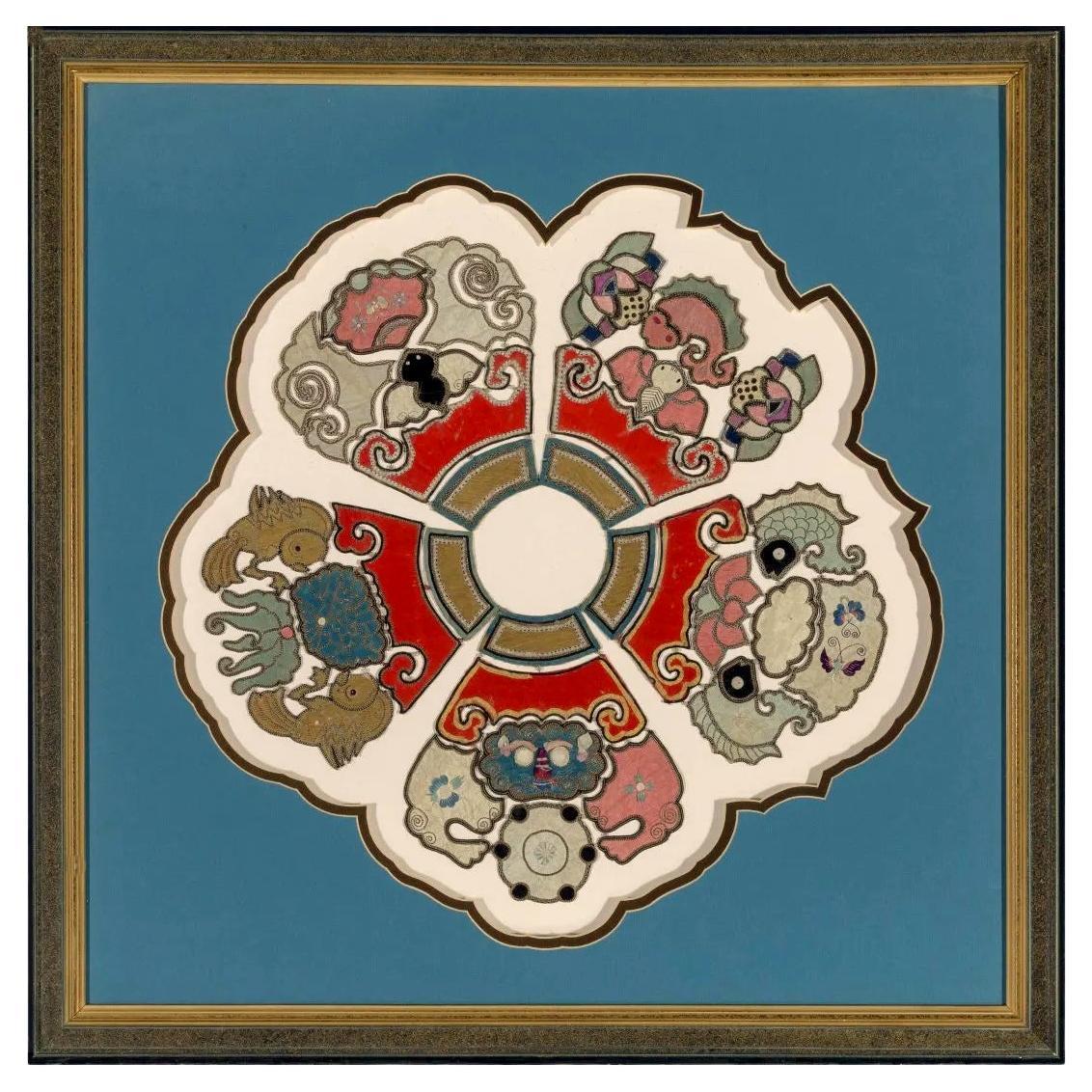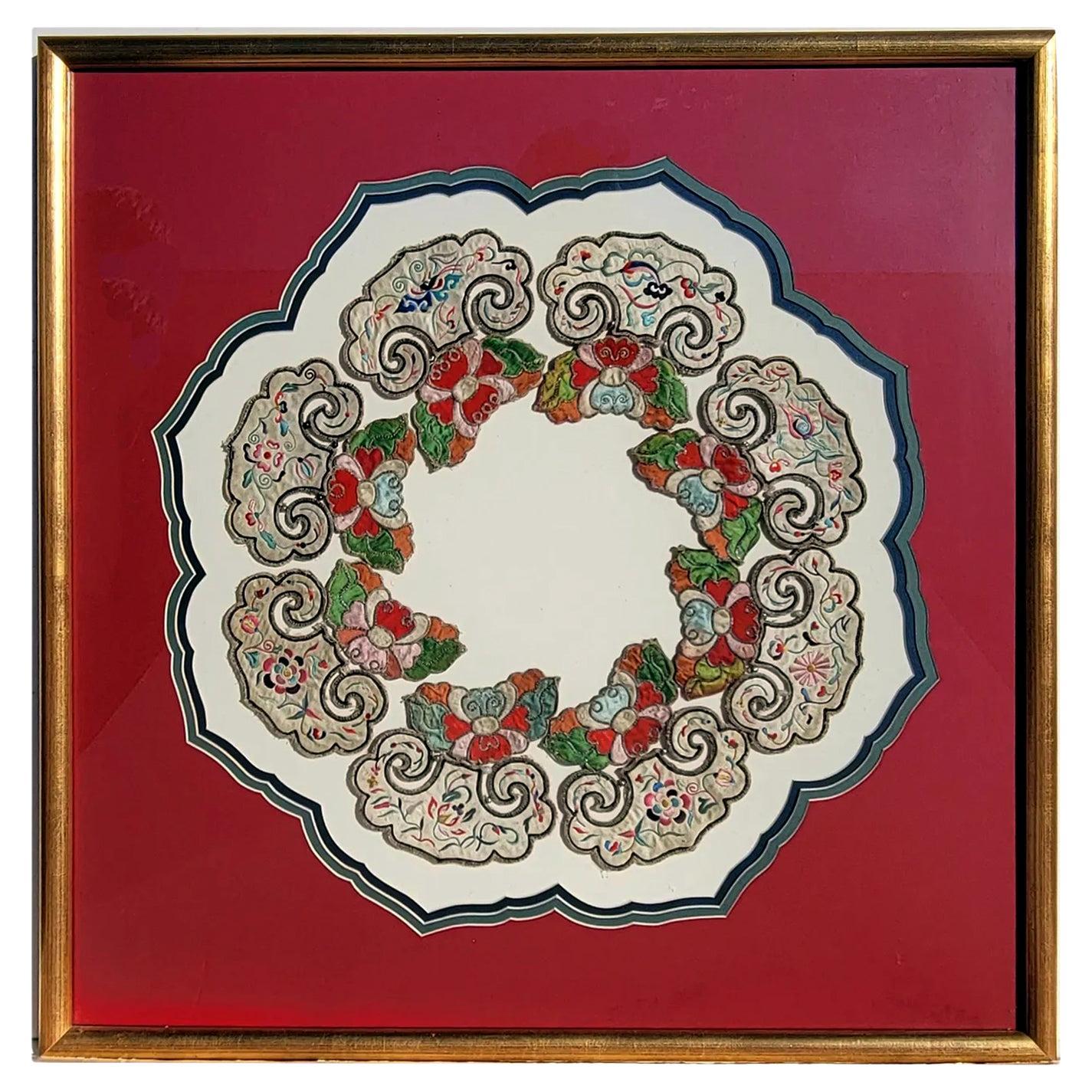Items Similar to Chinese Silk Embroidered Screen or Room Divider Believed to Be Late Qing Dynasty
Video Loading
Want more images or videos?
Request additional images or videos from the seller
1 of 22
Chinese Silk Embroidered Screen or Room Divider Believed to Be Late Qing Dynasty
About the Item
What a magnificent one-of-a-kind Valentine's Day gift this would be! Wow!!
Four panel Chinese silk embroidered screen or room divider believed to be created during the late Qing Dynasty. Four ivory silk embroidered panels housed in a wooden frame form the screen or room divider. The 100 bird pattern in embroidered muted colours depicts exotic birds, insects, and auspicious flora. The embroidery is fine, composition is balanced, colours are exquisitely blended, and there are no loose threads. There are faint brown spots on each panel (See photos), but there are no holes. The staining of the wood frame is uneven in places and looks like it was done later, after the panels were in place. Each panel is covered by glass that looks old (slight rippling and bubbles) and is very heavy. Each panel out of the frame is 50 inches high X 13 inches wide with black leather backing. There are no signatures visible, although only one panel has been removed to check edges under the frames. This beautiful framed silk on silk embroidered screen can act as a room divider or stunning focal point of any room.
Note: This item is large, heavy, and fragile. Local delivery in Nova Scotia is free. Nova Scotia is an Eastern Canadian province surrounded by the ocean with picturesque vistas and so much to see and do. Summer and fall are perfect times to visit. Whether driving or flying, I'd be happy to meet you anywhere 1.5 hours from Halifax to deliver this treasure.
- Dimensions:Height: 66 in (167.64 cm)Width: 64 in (162.56 cm)Depth: 1.5 in (3.81 cm)
- Style:Qing (Of the Period)
- Materials and Techniques:
- Place of Origin:
- Period:
- Date of Manufacture:1850-1911
- Condition:Refinished. Wear consistent with age and use. The frame was re-painted. The panel that was removed is not as well secured as the others and will require care when opening the screen. Otherwise it will stay in place.
- Seller Location:Nova Scotia, CA
- Reference Number:1stDibs: LU7091229540002
About the Seller
5.0
Vetted Seller
These experienced sellers undergo a comprehensive evaluation by our team of in-house experts.
Established in 2022
1stDibs seller since 2022
11 sales on 1stDibs
Typical response time: 1 hour
- ShippingRetrieving quote...Ships From: Nova Scotia, Canada
- Return PolicyA return for this item may be initiated within 3 days of delivery.
More From This SellerView All
- Chinese Silk Embroidery - Vintage Signed Piano ShawlLocated in Nova Scotia, NSWhat a magnificent one-of-a-kind Valentine's Day gift this would be! Wow!! This Chinese silk embroidered shawl is signed by the maker--a very rare find, indeed. This piece is also known as a Canton Manton de Manila...Category
Mid-20th Century Chinese Art Deco Textiles
MaterialsSilk, Fabric, Textile, Thread, Organic Material
- Chinese Nephrite Jade Archaistic Covered Vase, Qing DynastyLocated in Nova Scotia, NSThis archaistic style lidded vase or censer is a lovely piece of jade. It consists of a flattened baluster body and figural handles with hanging rings. The front and back body are ca...Category
Antique 19th Century Chinese Archaistic Antiquities
MaterialsStone, Jade
- White Jade Double Gourd Pendant, Qing DynastyLocated in Nova Scotia, NSThis antique nephrite jade double gourd pendant is of the Qing Dynasty and has a fine texture with a glossy luster. It is primarily white with some slight inclusions in the left lower body but in bright light the pendant has a slight green tinge. This lovely jade pendant consists of a smaller gourd on top of a larger one surrounded by vines with smaller hanging gourds. The vines create numerous holes from which to hang the pendant. There are also etchings of stars on the body of the gourds along with tendrils of curling vines. In the Chinese culture, the double gourd is a symbol of fertility and good fortune. Gourds are also associated with Li Tie Guai, one of the eight immortals. This lovely jade pendant was purchased from a private collection along with a magnificent antique Chinese silk...Category
Antique 19th Century Chinese Qing Antiquities
MaterialsStone, Jade
- Antique Hand-Painted Porcelain Picture of Peonies, Fruit Blossoms, and LiliesLocated in Nova Scotia, NSThis lovely and rare hand-painted porcelain picture with a floral motif consists of tree peonies, fruit blossoms, and lilies, all of which are auspicious flowers in Chinese culture. ...Category
Early 20th Century Chinese Qing Paintings and Screens
MaterialsCeramic, Clay, Luster, Porcelain, Wood, Hardwood, Paint
- Natural Spinach Jade Animal Figurines from Qing DynastyLocated in Nova Scotia, NSThese lovely spinach jade animal figures consist of a Tang horse, an elephant, and a hippo. The largest is the Tang horse at 8cm x 6cm x 2.2cm, and the smallest is the elephant at 6.2cm x 5.2cm x 2.2cm. These animal figures were purchased from a collection that included museum quality Asian antiques such as a large Meiji period silk embroidered tapestry...Category
Antique Late 19th Century Chinese Qing Antiquities
MaterialsStone, Jade
- White Jade Dragon with Pearl Pendant, Qing DynastyLocated in Nova Scotia, NSThis antique Qing Dynasty nephrite jade pendant consists of a dragon with a pearl in its mouth. There is decorative etching on the body, and the head and mouth are well defined. The pendant has a semi-fine texture with a semi-gloss or slightly waxy luster. This lovely piece of jade is white and has a very slight green tinge in certain lighting. In the Chinese culture, the dragon symbolizes prosperity and good fortune, while the pearl is a symbol of wisdom, spiritual energy, and power. The dragon with a pearl is also a common theme in Chinese imagery and is the subject of myth and legend. This lovely jade pendant was purchased from a private collection along with a magnificent antique Chinese silk...Category
Antique 19th Century Chinese Qing Antiquities
MaterialsStone, Jade
You May Also Like
- Framed Pair of Antique Chinese Qing Dynasty Ancestor Paintings on SilkLocated in Morristown, NJAntique pair of Qing dynasty ancestor portraits depicting a male and a female. Hand painted on silk and framed under glass within a large te...Category
Antique Late 19th Century Chinese Qing Paintings and Screens
MaterialsSilk, Glass, Wood, Paint
- Framed Chinese Embroidered Silk Collar Qing DynastyLocated in Atlanta, GAAn embroidered silk collar from China dated to late Qing Dynasty circa 19th century. Known as Yunjian (Cloud Shoulder or Cloud Collar), this multi-lobed t...Category
Antique Early 19th Century Chinese Qing Textiles
MaterialsSilk
- Framed Chinese Embroidered Silk Collar Qing DynastyLocated in Atlanta, GAA silk collar from China dated to late Qing Dynasty circa 19th century. Known as Yunjian (Cloud Shoulder or Cloud Collar), this multi-lobed textile piece was a detachable collar worn around the shoulders as part of the traditional Chinese garment accessory. With its origin dated back to the Han Dynasty and being used until the end of Qing Dynasty, the form evolves with time, but much of the ornamentation and fundamental symbolism remains the same. This striking example features a two-tiered design with seven lobes on each circle, all of which are variations of the shape of auspicious "ruyi", which represents the head of Lingzhi mushroom, a symbol of longevity. The inner lobes feature elaborate embroidery floral design with long and short satin stitches. Notably, one panel has a double gourd design, the symbol of fortune. The outer lobes show a simpler but bolder vision with the outlines of the designs lineated with metallic threads buddled in chain stitches. Small jade beads were used to link the piece together and most of them still remain. The piece as a whole has a very pleasant lilac purple color, delicate with the jade beads. In Qing Dynasty, the silk collar with high quality was worn by noble or aristocratic women. The red color and the lotus boy symbol indicate that it was most likely part of the fashion accouterment worn during wedding ceremony. The collar is beautifully float mounted within a double conforming mat in a giltwood frame and wood backing. A stunningly presented period piece with story to tell. Reference: For a collection of Chinese embroidered collars...Category
Antique Early 19th Century Chinese Qing Textiles
MaterialsSilk
- Framed Chinese Embroidered Silk Collar Qing DynastyLocated in Atlanta, GAAn embroidered silk collar from China dated to late Qing Dynasty circa 19th century. Known as Yunjian (Cloud Shoulder or Cloud Collar). This striking example features a two-tiered design with eleven inner and outer lobes radiating in a circular fashion. The red inner lobes feature floral embroidery design in satin stitches, the border with twisted chain stitches. The outer lobes are in the shape of auspicious "ruyi", which represents the head of Lingzhi mushroom, a symbol of longevity. Each showcases fine needlework of butterfly with spread wings and various floral motif. A small ball clasp remains on the front. This textile art is beautifully presented in a giltwood frame floating within a double mat of conforming shape. Detachable collars such as this were worn around the shoulders as part of the traditional Chinese garment...Category
Antique 19th Century Chinese Qing Textiles
MaterialsSilk
- Framed Chinese Embroidered Silk Collar Qing DynastyLocated in Atlanta, GAA silk collar from China dated to late Qing Dynasty circa 19th century. Known as Yunjian (Cloud Shoulder or Cloud Collar), this two-tiered, five-lobed textile piece was a detachable collar worn around the shoulders as part of the traditional Chinese garment...Category
Antique Early 19th Century Chinese Qing Textiles
MaterialsSilk
- Framed Chinese Embroidered and Appliqued Silk Collar Qing DynastyLocated in Atlanta, GAA silk collar from China dated to late Qing Dynasty circa 19th century. Known as Yunjian (Cloud Shoulder or Cloud Collar), this multi-lobed textile piece was a detachable collar worn around the shoulders as part of the traditional Chinese garment accessory. With its origin dated back to the Han Dynasty and being used until the end of Qing Dynasty, the form evolves with time, but much of the ornamentation and fundamental symbolism remains the same. This striking example features a two-tiered design with eight lobes on each circle, all of which are variations of the shape of auspicious "ruyi", which represents the head of Lingzhi mushroom, a symbol of longevity. The inner lobes were made with appliqued patchwork of colorful silk. The outer lobes feature elaborate embroidery of assortment of colorful flowers, scrolling ribbons and butterfly, using mostly long and short satin stitches. The borders and outlines of the designs were lineated with metallic threads buddled in chain stitches. Small black pearls were used to link the piece together and most of them still remain. In Qing Dynasty, the silk collar with high quality was worn by noble or aristocratic women. The red color and the lotus boy symbol indicate that it was most likely part of the fashion accouterment worn during wedding ceremony. The collar is beautifully float mounted within a double conforming mat in a giltwood frame and wood backing. A stunningly presented period piece with story to tell. Reference: For a collection of Chinese embroidered collars...Category
Antique Early 19th Century Chinese Qing Textiles
MaterialsSilk
Recently Viewed
View AllMore Ways To Browse
Antique Be
Antique Divider
Bird Patterns
Chineses Silk
China Silk
Antique Room Screen
Antique Room Screens
Screen Glass
Screens With Fabrics
Antique Room Divider
Room Divider Antique
Antique Room Divider Furniture
Dividing Screen
Divider Screen
Antique Silk Fabric Silk
Screen Divider Used
Antique Chinese Silk
Chinese Antique Silk





